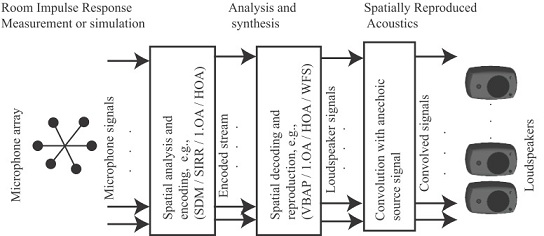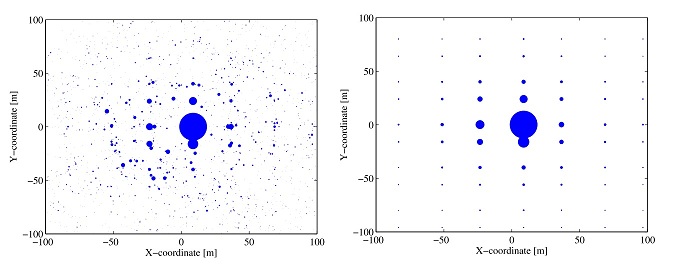- Details
- Published: 09 January 2013
Detailed analysis of room acoustics requires spatial analysis. The spatial analysis studies the acoustics from measured spatial room impulse responses. The spatial room impulse response is measured with a microphone array and one or more loudspeakers using standard impulse response measurement techniques. Recent research has proposed several approaches for analyzing and visualizing the spatial analysis results [1,2,3]. A straightforward method for spatial analysis is presented by Tervo et al. in [4], named as spatial decomposition method (SDM). The advantage over the other approaches is that the proposed method can be applied to an arbitrary microphone array.
This method is also able to reproduce the spatial sound field over any spatial sound reproduction method. Below, the technique is described in more detail.
This page reviews a spatial encoding method for room impulse responses. The method is based on decomposing the spatial room impulse responses into a set of image-sources. The resulting image-sources can be used for room acoustics analysis and for multi-channel convolution reverberation engines. The analysis method is applicable for any compact microphone array and the reproduction can be realized with any of the current spatial reproduction methods.
Figure 1 illustrates the basic principles in spatial sound analysis and synthesis using spatial room impulse responses. First, the spatial room impulse response is measured with a microphone array. Second, it is processed with the proposed method in to image-sources which are then fed to the spatial reproduction method. The output of the spatial processing method is convolved with anechoic source signal for auralization.
In Figure 2, the output of the SDM is compared to the original simulated image-sources (left). The size of the circle corresponds to amplitude, and z-coordinate is not shown for clarity. As seen from Figure 2, SDM is able to localize the direct sound and first reflections correctly, which are the most prominent cues for spatial impression of the space.
References
[1] D Khaykin and B Rafaely: Acoustic analysis by spherical microphone array processing of room impulse responses. J. Acoust. Soc. Am. 132(1):261-270, 2012. URL, DOI BibTeX / Info
@article{Khaykin2012,
author = "D. Khaykin and B. Rafaely",
title = "Acoustic analysis by spherical microphone array processing of room impulse responses",
year = 2012,
journal = "J. Acoust. Soc. Am.",
volume = 132,
number = 1,
pages = "261-270",
keywords = "acoustic signal processing; acoustic wave reflection; architectural acoustics; array signal processing; direction-of-arrival estimation; matrix algebra; microphone arrays; smoothing methods; spectral analysis",
url = "http://link.aip.org/link/?JAS/132/261/1",
doi = "10.1121/1.4726012"
}
[2] A O'Donovan, R Duraiswami and D Zotkin. Imaging concert hall acoustics using visual and audio cameras. In IEEE International Conference on Acoustics, Speech and Signal Processing, 2008. 2008, 5284 -5287. BibTeX / Info
@inproceedings{Donovan2008,
author = "A. O'Donovan and R. Duraiswami and D. Zotkin",
booktitle = "IEEE International Conference on Acoustics, Speech and Signal Processing, 2008",
title = "Imaging concert hall acoustics using visual and audio cameras",
year = 2008,
month = "31 2008-april 4",
pages = "5284 -5287",
issn = "1520-6149"
}
[3] J Merimaa and V Pulkki: Spatial Impulse Response Rendering I: Analysis and Synthesis. J. Audio Eng. Soc 53(12):1115–1127, 2005. URL BibTeX / Info
@article{Merimaa2005,
title = "Spatial Impulse Response Rendering I: Analysis and Synthesis",
author = "Merimaa, J. and Pulkki, V.",
journal = "J. Audio Eng. Soc",
volume = 53,
number = 12,
pages = "1115--1127",
year = 2005,
url = "http://www.aes.org/e-lib/browse.cfm?elib=13401"
}
[4] S Tervo, J Pätynen and T Lokki: Spatial Decomposition Method for Room Impulse Responses. J. Audio Eng. Soc 61(1):1–13, 2013. BibTeX / Info
@article{Tervo2013,
title = "Spatial Decomposition Method for Room Impulse Responses",
author = {Tervo, S. and P\"{a}tynen, J. and Lokki, T.},
journal = "J. Audio Eng. Soc",
volume = 61,
number = 1,
pages = "1--13",
year = 2013
}





